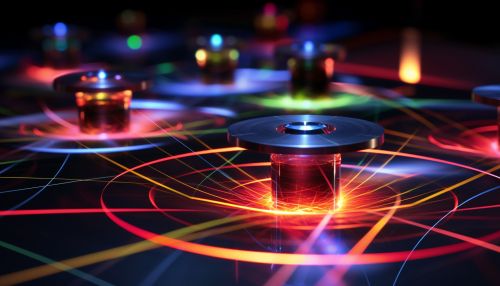The Physics of Quantum Computing with Quantum Optical Systems
Introduction
Quantum computing is a rapidly evolving field that leverages the principles of quantum mechanics to perform computational tasks. One of the key technologies in this field is the use of quantum optical systems, which use light particles, or photons, to carry quantum information.


Quantum Mechanics and Quantum Computing
Quantum mechanics is a fundamental theory in physics that describes the physical phenomena at the nanoscopic scales, where the action is on the order of the Planck constant. It departs from classical mechanics primarily at the quantum realm of atomic and subatomic length scales. Quantum mechanics provides a mathematical description of much of the dual particle-like and wave-like behavior and interactions of energy and matter.
Quantum computing, on the other hand, is a type of computation that utilizes quantum bits, or qubits, to perform operations. Unlike classical bits, which can be either a 0 or a 1, a qubit can be in a state of superposition, meaning it can be both a 0 and a 1 at the same time. This property, along with entanglement, where qubits become interconnected and the state of one can instantly affect the state of the other, no matter the distance, provides quantum computers with a significant increase in computational power.
Quantum Optical Systems
Quantum optical systems are a subset of quantum computing systems that use photons as their primary information carriers. These systems leverage the wave-particle duality of light to create and manipulate qubits. The most common type of quantum optical system is a linear optical system, where the quantum state of light is manipulated using linear optical elements such as beam splitters and phase shifters.
Principles of Quantum Optics
Quantum optics is the study of how individual quanta of light, known as photons, interact with atoms and molecules. This includes studying the particle-like properties of photons. Photons have been used to test many of the counter-intuitive predictions of quantum mechanics, such as entanglement and quantum superposition, and are a useful resource for quantum computing.
Quantum Information Processing with Optical Systems
Quantum information processing is the manipulation and utilization of quantum information, which is stored and manipulated using the principles of quantum mechanics. In quantum optical systems, quantum information processing involves the use of photons to carry information, which is processed using quantum gates and quantum circuits.
Quantum Gates and Quantum Circuits
In quantum computing, a quantum gate is a basic quantum circuit operating on a small number of qubits. They are the building blocks of quantum circuits, like classical logic gates are for conventional digital circuits. Unlike many classical logic gates, quantum logic gates are reversible.
A quantum circuit is a sequence of quantum gates. Quantum circuits are used to perform quantum computations. The complexity of a quantum circuit can be measured by the number of quantum gates in the circuit, the depth of the circuit (the maximum number of gates in a computational path), or the number of qubits in the circuit.
Quantum Algorithms
Quantum algorithms are a set of instructions used in quantum computing to perform a task or solve a problem. They leverage the principles of quantum mechanics to perform computations more efficiently than classical algorithms. Some of the most well-known quantum algorithms include Shor's algorithm for factoring large numbers and Grover's algorithm for searching unsorted databases.
Quantum Error Correction
Quantum error correction is a set of techniques for correcting errors that occur in quantum computing systems. These errors can be caused by various factors, including decoherence, which is the loss of quantum information to the environment. Quantum error correction is a crucial aspect of quantum computing, as it allows quantum computers to operate in real-world environments.
Quantum Communication and Quantum Cryptography
Quantum communication is the use of quantum mechanics to transmit information. One of the most well-known applications of quantum communication is quantum cryptography, which uses quantum mechanics to secure communication. Quantum key distribution is a quantum cryptography protocol that allows two parties to produce a shared random secret key known only to them, which can then be used to encrypt and decrypt messages.
Future of Quantum Computing with Quantum Optical Systems
The future of quantum computing with quantum optical systems is promising. With advancements in technology and a better understanding of quantum mechanics, quantum optical systems could play a crucial role in the development of powerful quantum computers. These systems could potentially revolutionize various fields, including cryptography, material science, and artificial intelligence.
